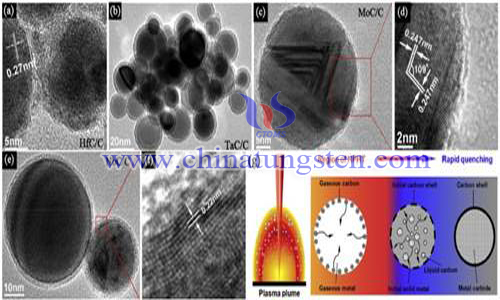Carbon-coated Potassium Phosphotungstate Preparation
- Details
- Category: Tungsten Information
- Published on Monday, 28 January 2019 22:20
Potassium phosphotungstate (K3PW12O40) is a kind of Heteropoly acid. Potassium phosphotungstate, as a cathode active material in the molecular cluster of Heteropoly acid, has attracted much attention due to its reversible multi-electron redox reaction, which enables it to achieve a high specific capacity of 260 Ah/kg (ordinary Li2CoO2 lithium ion battery is 150 Ah/kg) and fast charge-discharge performance.

XAFS X-ray wave studies show that the electron transfer of heteropoly acids during redox process indicates that the conversion of 24 electrons from [PMo(VI)12O40]3-state to [PMo(VI)12O40]27-is an important factor for the high specific capacity of heteropoly acid batteries. Potassium phosphotungstate can also be used as a high performance secondary battery material because of its large number of electronic storage characteristics. However, the bottleneck of its commercialization lies in the poor conductivity of potassium phosphotungstate, which directly affects the application of potassium phosphotungstate in lithium-ion batteries due to the difficulty of lithium ion embedding and stripping microcrystalline structure and non-smooth electron transfer channels.
In order to solve the problem of poor conductivity of potassium phosphotungstate, some scholars have designed a preparation scheme of carbon-coated potassium phosphotungstate microcube. According to its published contents, the scheme roughly includes the following steps:
1) Preparation of potassium phosphotungstate microcubstances:
The 800 mg phosphotungstic acid was dissolved in 150 ml beaker by 120 ml water ultrasound, and the solution of phosphotungstic acid with the concentration of 2.3 *10-3 mol/L was obtained. 600 mg potassium chloride in 150 mL beaker was dissolved uniformly by adding 120 mL water ultrasound, and 6.7 x 10-2 mol/L potassium chloride aqueous solution was obtained. The water solution of phosphotungstic acid was put into a 500 mL three-hole flask, heated to 100 ℃ in oil bath, then the prepared potassium chloride solution was added to the above-mentioned water solution of phosphotungstic acid at 100 ℃, stirred for 1 h at 100 ℃ to form potassium phosphotungstate micro-cubic emulsion. After the reaction, the potassium phosphotungstate micro-cubic emulsion was cooled to room temperature, centrifuged, washed and separated by solid phase, and dried to obtain potassium phosphotungstate micro-cubic.
2)Carbon-coated potassium phosphotungstate micro-cubic composites were prepared.
The potassium phosphotungstate microcube was dispersed in the mixed solution of ethanol and deionized water, then ammonia water, tetraethyl orthosilicate, resorcinol and formaldehyde were added. The stirring reaction was washed and dried until the end of the stirring reaction. The dried solid powder was calcined under the protection of nitrogen. The calcined solid powder was etched in HF acid for 12 hours to remove silicon dioxide and centrifuge to obtain carbon. Potassium phosphotungstate microcubic composites coated with potassium phosphotungstate.
The carbon-coated potassium phosphotungstate micro-cube prepared by this method has smaller size and uniform morphology, which is beneficial to solve the problem of lithium ion intercalation and removal in microcrystalline structure. After the completion of the process, K3PW12O40 potassium phosphotungstate microcube has been completely encapsulated in thin carbon layer, which makes use of the excellent structural stability of carbon, conductivity, and can provide more lithium insertion sites, thus improving the discharge capacity of lithium-ion batteries prepared with the composite material. The prepared composite material can be used as cathode material of lithium-ion batteries, which can improve the impurities of lithium-ion batteries. The conductivity of acid molecular cluster batteries has great potential for market development.
- Tungsten Oxide Manufacturer & Supplier, Chinatungsten Online: www.tungsten-oxide.com
- Tungsten News & Prices of China Tungsten Industry Association: www.ctia.com.cn
- Molybdenum News & Price: news.molybdenum.com.cn
- Tel.: 86 592 5129696; Fax: 86 592 5129797; Email: sales@chinatungsten.com



 sales@chinatungsten.com
sales@chinatungsten.com